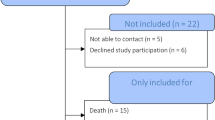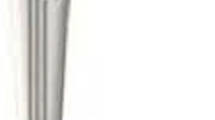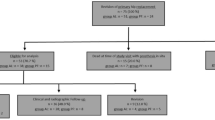Abstract
Introduction
The purpose of this retrospective registry-based study is to assess survival and causes of failure of cementless stem implants used in total hip arthroplasty (THAs), to ascertain if there are differences when these are categorized according to the six types described by Mont.
Methods
Data collected from the regional registry regarding all primary THAs performed from 2000 to 2019 were analyzed. Femoral prosthetic stems were divided into the six types of Mont classification. For each stem type, number of implants, survival and causes of failure were evaluated and compared.
Results
The most frequently implanted stem type was the 3c type (53.4%). Type 1 had the lowest stem failure rate (1.6%), and type 6 showed the highest (3.9%). Periprosthetic fracture was the most frequent complication in type 6, accounting for 34.5% of failures. Aseptic loosening was the main complication in type 2 stems, accounting for 36.4% of failures. Pairwise comparisons showed significant higher survival of type 1 compared to type 3c (p = 0.000026) and type 6 (p = 0.000076), and between type 3a compared to type 3c (p = 0.03) and type 6 (p = 0.026).
Conclusion
Significant variations in implant survival rates were found among the six Mont-types of cementless stems. These findings emphasize the paramount importance of stem design and fixation area in determining long-term survival, providing a guidance for orthopedic surgeons in the selection of the most appropriate stem for primary THA, contributing to our understanding of cementless stem performance, presenting invaluable insights to further improve patient outcomes in THA surgery.




Similar content being viewed by others
Data availability
The data that support the findings of this study are available from the corresponding author, A.D.M., upon reasonable request.
References
Long H, Liu Q, Yin H, Wang K, Diao N, Zhang Y et al (2022) Prevalence trends of site-specific osteoarthritis from 1990 to 2019: findings from the global burden of disease study 2019. Arthritis Rheumatol luglio 74(7):1172–1183
Learmonth ID, Young C, Rorabeck C (2007) The operation of the century: total hip replacement. The Lancet Ottobre 370(9597):1508–1519
Duwelius PJ, Southgate RD, Crutcher JP, Rollier GM, Li HF, Sypher KS et al (2023) Registry data show complication rates and cost in revision hip arthroplasty. J Arthroplasty luglio 38(7):S29-33
Registro Italiano ArtroProtesi (RIAP), Report Annuale 2021. https://riap.iss.it/riap/it/attivita/report/2022/10/27/report-annuale-riap-2021/. Accessed 5 May 2023
Registro Regionale di Implantologia Protesica Ortopedica (RIPO), dati complessivi interventi di protesi d’anca, di ginocchio e di spalla in Emilia Romagna, Rendiconto Attività 2000–2019. https://ripo.cineca.it/authzssl/index.htm. Accessed 3 May 2023.
Shichman I, Kurapatti M, Roof M, Christensen TH, Rozell JC, Schwarzkopf R (2022) Impact of Indication for Revision THA on Resource Utilization. J Arthroplasty Dicembre 37(12):2333–2339
Scott CEH, Turnbull GS, Powell-Bowns MFR, MacDonald DJ, Breusch SJ (2018) Activity levels and return to work after revision total hip and knee arthroplasty in patients under 65 years of age. Bone Jt J Agosto 100-B(8):1043–1053
Kelmer G, Stone AH, Turcotte J, King PJ (2021) Reasons for revision: primary total hip arthroplasty mechanisms of failure. J Am Acad Orthop Surg 29(2):78–87
Kummerant J, Wirries N, Derksen A, Budde S, Windhagen H, Floerkemeier T (2020) The etiology of revision total hip arthroplasty: current trends in a retrospective survey of 3450 cases. Arch Orthop Trauma Surg 140(9):1265–1273
Charnley J (1961) Arthroplasty of the hip. A new operation. Lancet 1(7187):1129–1132. https://doi.org/10.1016/s0140-6736(61)92063-3
Berry DJ (2000) Evolution of uncemented femoral component design. In: Pellicci PM, Tria AJ, Garvin KL (eds) Orthopaedic knowledge update: hip and knee reconstruction 2, 2nd edn. American Academy of Orthopaedic Surgeons, Rosemont, pp 117–127
Noble PC, Alexander JW, Lindahl LJ, Yew DT, Granberry WM, Tullos HS (1988) The anatomic basis of femoral component design. Clin Orthop 235:148–165
Giardina F, Castagnini F, Stea S, Bordini B, Montalti M, Toni A (2018) Short stems versus conventional stems in cementless total hip arthroplasty: a long-term registry study. J Arthroplasty 33(6):1794–1799
Maloney WJ, Jasty M, Rosenberg A, Harris WH (1990) Bone lysis in well-fixed cemented femoral components. J Bone Jt Surg Br 72(6):966–970. https://doi.org/10.1302/0301-620X.72B6.2246299
Jones LC, Hungerford DS (1987) Cement disease. Clin Orthop Relat Res 225:192–206
Meding JB, Ritter MA, Keating ME, Berend ME (2015) Twenty-year followup of an uncemented stem in primary THA. Clin Orthop febbraio 473(2):543–548
Huo MH, Dumont GD, Knight JR, Mont MA (2011) What’s new in total hip arthroplasty. J Bone Joint Surg Am 93(20):1944–1950. https://doi.org/10.2106/JBJS.K.00656
Khanuja HS, Vakil JJ, Goddard MS, Mont MA (2011) Cementless femoral fixation in total hip arthroplasty. J Bone Jt Surg 93(5):500–509
Lord GA, Hardy JR, Kummer FJ (1979) An uncemented total hip replacement: experimental study and review of 300 madreporique arthroplasties. Clin Orthop Relat Res 141:2–16
Report_RIAP_2021–2.pdf. https://riap.iss.it/riap/it/. Accessed 25 Apr 2023
Swedish register Annual Report 2021.pdf. https://sar.registercentrum.se/about-the-register/annual-reports/p/SJW4-ZGyo. Accessed 25 Apr 2023
NJR 19th Annual Report 2022.pdf. https://www.hqip.org.uk/wp-content/uploads/2022/11/NJR-19th-Annual-Report-2022.pdf. Accessed 25 Apr 2023
Bourne RB, Rorabeck CH, Burkart BC, Kirk PG (1994) Ingrowth surfaces. Plasma spray coating to titanium alloy hip replacements. Clin Orthop Relat Res 298:37–46
Pilliar RM (1983) Powder metal-made orthopedic implants with porous surface for fixation by tissue ingrowth. Clin Orthop Relat Res 176:42–51
Callaghan JJ (1993) The clinical results and basic science of total hip arthroplasty with porous-coated prostheses. J Bone Joint Surg Am 75(2):299–310. https://doi.org/10.2106/00004623-199302000-00020
Cook SD, Thomas KA, Kay JF, Jarcho M (1988) Hydroxyapatite-coated titanium for orthopedic implant applications. Clin Orthop Relat Res 232:225–243
Søballe K, Hansen ES, Brockstedt-Rasmussen H, Bünger C (1993) Hydroxyapatite coating converts fibrous tissue to bone around loaded implants. J Bone Joint Surg Br 75:270–278
Søballe K, Overgaard S (1996) The current status of hydroxyapatite coating of prostheses. J Bone Joint Surg Br 78:689–691
Zweymüller KA, Lintner FK, Semlitsch MF (1988) Biologic fixation of a press-fit titanium hip joint endoprosthesis. Clin Orthop Relat Res 235:195–206
Bingham JS, Hart A, Abdel MP (2017) The evolvement of cementless stems: risks and rewards. Semin Arthroplasty 28(4):215–223
Kheir MM, Drayer NJ, Chen AF (2020) An update on cementless femoral fixation in total hip arthroplasty. J Bone Joint Surg Am 102(18):1646–1661. https://doi.org/10.2106/JBJS.19.01397
Liu Y, Li C, Cao Z, Wang X, Wen J, Ping H, Kong X, Chai W (2023) Undetected intraoperative periprosthetic femoral fractures in patients undergoing primary total hip arthroplasty: a retrospective case series and literature review. Orthop Surg 15(3):758–765. https://doi.org/10.1111/os.13646. (Epub 2023 Jan 17)
Radaelli M, Buchalter DB, Mont MA, Schwarzkopf R, Hepinstall MS (2023) A new classification system for cementless femoral stems in total hip arthroplasty. J Arthroplasty 38(3):502–510. https://doi.org/10.1016/j.arth.2022.09.014. (Epub 2022 Sep 17)
Burt CF, Garvin KL, Otterberg ET, Jardon OM (1998) A femoral component inserted without cement in total hip arthroplasty. A study of the Tri-Lock component with an average ten-year duration of follow-up. J Bone Joint Surg Am 80(7):952–960. https://doi.org/10.2106/00004623-199807000-00003
Sharkey PF, Albert TJ, Hume EL, Rothman RH (1990) Initial stability of a collarless wedge-shaped prosthesis in the femoral canal. Semin Arthroplasty 1(1):87–90
Hozack WJ, Booth RE Jr (1990) Clinical and radiographic results with the Trilock femoral component–a wedge-fit porous ingrowth stem design. Semin Arthroplasty 1(1):64–69
Vresilovic EJ, Hozack WJ, Rothman RH (1994) Radiographic assessment of cementless femoral components. Correlation with intraoperative mechanical stability. J Arthroplasty 9(2):137–141. https://doi.org/10.1016/0883-5403(94)90062-0
Müller LA, Wenger N, Schramm M, Hohmann D, Forst R, Carl HD (2010) Seventeen-year survival of the cementless CLS Spotorno stem. Arch Orthop Trauma Surg 130(2):269–275. https://doi.org/10.1007/s00402-009-0969-7
Lombardi AV Jr, Berend KR, Mallory TH, Skeels MD, Adams JB (2009) Survivorship of 2000 tapered titanium porous plasma-sprayed femoral components. Clin Orthop Relat Res 467(1):146–154. https://doi.org/10.1007/s11999-008-0568-x. (Epub 2008 Oct 31)
Bourne RB, Rorabeck CH, Patterson JJ, Guerin J (2001) Tapered titanium cementless total hip replacements: a 10- to 13-year followup study. Clin Orthop Relat Res 393:112–120
Wagner H, Wagner M (2000) Cone prosthesis for the hip joint. Arch Orthop Trauma Surg 120(1–2):88–95. https://doi.org/10.1007/pl00021223
Park MS, Choi BW, Kim SJ, Park JH (2003) Plasma spray-coated Ti femoral component for cementless total hip arthroplasty. J Arthroplasty 18(5):626–630. https://doi.org/10.1016/s0883-5403(03)00203-1
Ellison B, Berend KR, Lombardi AV Jr, Mallory TH (2006) Tapered titanium porous plasma-sprayed femoral component in patients aged 40 years and younger. J Arthroplasty 21(6 Suppl 2):32–37. https://doi.org/10.1016/j.arth.2006.03.008
Mont MA, Yoon TR, Krackow KA, Hungerford DS (1999) Clinical experience with a proximally porous-coated second-generation cementless total hip prosthesis: minimum 5-year follow-up. J Arthroplasty 14(8):930–939. https://doi.org/10.1016/s0883-5403(99)90006-2
Noble PC, Alexander JW, Lindahl LJ, Yew DT, Granberry WM, Tullos HS (1988) The anatomic basis of femoral component design. Clin Orthop Relat Res 235:148–165
Callaghan JJ, Fulghum CS, Glisson RR, Stranne SK (1992) The effect of femoral stem geometry on interface motion in uncemented porous-coated total hip prostheses. Comparison of straight-stem and curved-stem designs. J Bone Joint Surg Am 74(6):839–848
Xenos JS, Callaghan JJ, Heekin RD, Hopkinson WJ, Savory CG, Moore MS (1999) The porous-coated anatomic total hip prosthesis, inserted without cement. A prospective study with a minimum of ten years of follow-up. J Bone Joint Surg Am 81(1):74–82. https://doi.org/10.2106/00004623-199901000-00011
Butler JB, Lansky D, Duwelius PJ (2005) Prospective evaluation of total hip arthroplasty with a cementless, anatomically designed, porous-coated femoral implant: mean 11-year follow-up. J Arthroplasty 20(6):709–716. https://doi.org/10.1016/j.arth.2004.11.011
Zhang Z, Zhuo Q, Chai W, Ni M, Li H, Chen J (2016) Clinical characteristics and risk factors of periprosthetic femoral fractures associated with hip arthroplasty: a retrospective study. Medicine (Baltimore) 95(35):e4751. https://doi.org/10.1097/MD.0000000000004751
Di Martino A, Rossomando V, Brunello M, D’Agostino C, Pederiva D, Frugiuele J, Pilla F, Faldini C (2023) How to perform correct templating in total hip replacement. Musculoskelet Surg 107(1):19–28. https://doi.org/10.1007/s12306-023-00772-3. (Epub 2023 Jan 11; Review)
Siddiqi A, Springer BD, Chen AF, Piuzzi NS (2021) Diagnosis and management of intraoperative fractures in primary total hip arthroplasty. J Am Acad Orthop Surg 29(10):e497–e512. https://doi.org/10.5435/JAAOS-D-20-00818
Di Martino A, Castagnini F, Stefanini N, Bordini B, Geraci G, Pilla F, Traina F, Faldini C (2021) Survival rates and reasons for revision of different stem designs in total hip arthroplasty for developmental dysplasia: a regional registry study. J Orthop Traumatol 22(1):29. https://doi.org/10.1186/s10195-021-00590-y
Di Martino A, Coppola MAR, Bordini B, Stefanini N, Geraci G, Pilla F, Traina F, Faldini C (2021) Clinical and radiological outcomes of total hip arthroplasty in patients affected by Paget’s disease: a combined registry and single-institution retrospective observational study. J Orthop Traumatol 22(1):13. https://doi.org/10.1186/s10195-021-00574-y
Zweymüller K, Semlitsch M (1982) Concept and material properties of a cementless hip prosthesis system with Al2O3 ceramic ball heads and wrought Ti-6Al-4V stems. Arch Orthop Trauma Surg (1978) 100(4):229–236. https://doi.org/10.1007/BF00381662
Grübl A, Chiari C, Giurea A, Gruber M, Kaider A, Marker M, Zehetgruber H, Gottsauner-Wolf F (2006) Cementless total hip arthroplasty with the rectangular titanium Zweymuller stem. A concise follow-up, at a minimum of fifteen years, of a previous report. J Bone Joint Surg Am 88(10):2210–2215. https://doi.org/10.2106/JBJS.E.00810
Suckel A, Geiger F, Kinzl L, Wulker N, Garbrecht M (2009) Long-term results for the uncemented Zweymuller/Alloclassic hip endoprosthesis. A 15-year minimum follow-up of 320 hip operations. J Arthroplasty 24(6):846–853. https://doi.org/10.1016/j.arth.2008.03.021. (Epub 2008 Sep 11)
Funding
This research did not receive any specific grant from funding agencies in the public, commercial, or not-for-profit sectors. The authors declare that no funds, grants, or other support were received during the preparation of this manuscript.
Author information
Authors and Affiliations
Contributions
All authors contributed to the study conception and design. All authors contributed to the study conception and design. Material preparation, data collection and analysis were performed by RF, MB, BB, VR, VD, FT, ADM. The first draft of the manuscript was written by CF and all authors commented on previous versions of the manuscript.
Corresponding author
Ethics declarations
Conflict of interest
All the authors declare that they have no conflict of interest. The authors have no relevant financial or non-financial interests to disclose.
Ethical approval
The study was conducted in accordance with the Declaration of Helsinki. Ethical approval for the study was not necessary because the registry collects data as standard practice on all patients, using a format protecting their identity.
Additional information
Publisher's Note
Springer Nature remains neutral with regard to jurisdictional claims in published maps and institutional affiliations.
Supplementary Information
Below is the link to the electronic supplementary material.
Rights and permissions
Springer Nature or its licensor (e.g. a society or other partner) holds exclusive rights to this article under a publishing agreement with the author(s) or other rightsholder(s); author self-archiving of the accepted manuscript version of this article is solely governed by the terms of such publishing agreement and applicable law.
About this article
Cite this article
Di Martino, A., Ferri, R., Bordini, B. et al. Long-term survival and complication rate of cementless prosthetic stems in primary total hip arthroplasty categorized by types according to Mont classification: a regional registry-based study on 53,626 implants. Arch Orthop Trauma Surg 144, 1423–1435 (2024). https://doi.org/10.1007/s00402-023-05144-x
Received:
Accepted:
Published:
Issue Date:
DOI: https://doi.org/10.1007/s00402-023-05144-x




